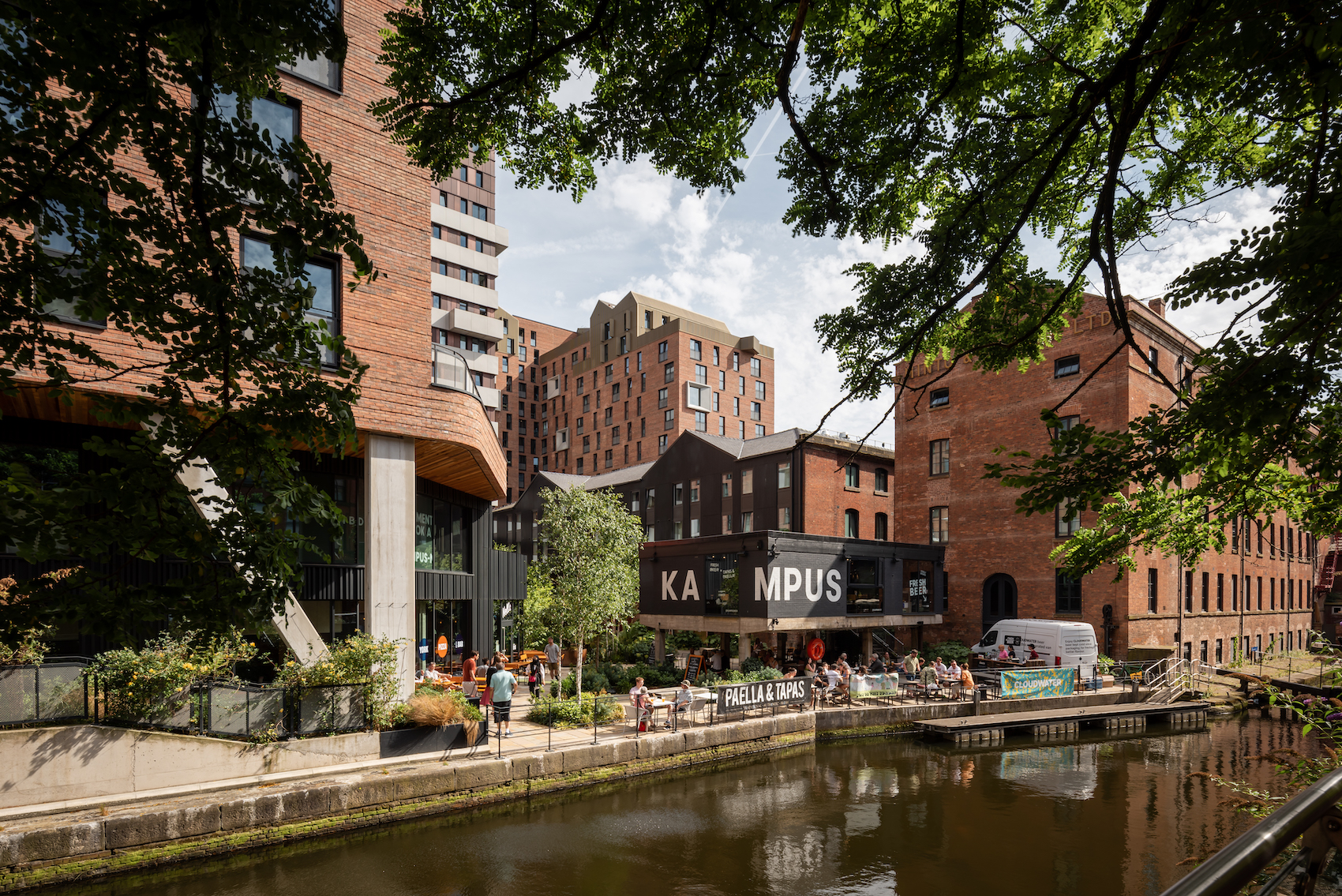Jeff Edwards, Engineering Manager for Leviat’s masonry division, answers readers’ questions on masonry support systems.
Leviat supplied a bespoke Ancon MDC masonry support system for Kampus, a £250m housing development in Manchester (photo: Greg Holmes)
What are the main types of masonry support system available, where are they typically used, and how are they commonly fixed
Masonry support systems come in various configurations to provide loadbearing support for masonry façades at horizontal movement joints (HMJs). They are also used above large openings, ribbon windows and undercrofts. Ancon MDC systems enable architects to be creative in their design choices, rather than limited by standardised options. The system comprises a continuous shelf angle with brackets welded to the rear spanning the cavity and fixing to the structure. Bracket spacing and geometry varies depending on the cavity size, support level, load and type of structure.
Masonry support systems are fixed to concrete using cast-in channels or post-fixed anchors. Cast-in channels are recommended (where suitable) to ensure maximum adjustment and minimise on-site drilling. Post-fixed anchors may be used at external corners if channels cannot support concentrated loads. For steelwork, isolated set screws or Ancon Steelgrip bolts are used depending on rear access availability.
What are the main design considerations when specifying masonry support systems?
Designs are often limited by the capacity of the fixings, so there is a balance between widening the vertical spacing of the HMJs (increasing the load applied) and the capacity of the fixings and structure. Another factor is the cavity size between the structure and masonry. The larger this is, the greater the bending moment and resulting bolt tension. A combination of large cavities, large masonry loads, fire barriers, and thinner slabs create design challenges.
A further consideration is concentrated loading. Lintels are supported by bearing onto piers between openings, resulting in concentrated loads at the piers, corners, or close to vertical movement joints, particularly where the system is close to the underside of openings. Other challenges include post-tension pockets, balcony connectors, and vent ducting affecting bracket positioning and design complexity. Structural integrity, feasibility, cost, and efficiency aspects must all be considered. Early engagement with a masonry support specialist is recommended to arrive at the most appropriate solutions.
What kinds of building tolerances need to be accommodated and how do support systems typically achieve these?
Vertical adjustment is provided in all Ancon support systems, with +/-20mm provided by serrated slots in the back of the brackets. Lateral adjustment is available through pushing the brick backwards on the angle or by shimming the system outwards. Loose shims may be used up to 12mm, with greater adjustment available through the use of prefabricated solid shim packs.
Longitudinal adjustment is almost unlimited when using cast-in channels, however when using post-fixed anchors or fixing to hollow steels, bolt positions must be carefully marked out and holes site-drilled. When fixing to steel UB sections, plates/angles are welded between the flanges to provide a fixing position. Prefabricated horizontal slots in these steels provide longitudinal tolerance.
How important are corrosion resistance and bi-metallic corrosion when it comes to specifying and detailing support systems and what can be done to mitigate them?
In short, very important! For this reason austenitic stainless steel is typically used for masonry support systems. Grade 1.4301 (304) is most commonly used and is suitable for a broad range of construction applications. However, in more aggressive environments, such as coastal and industrial locations, the specification of 1.4401 (316) material is recommended to mitigate corrosion. Leviat provides advice on suitable material specifications, but the responsibility for the specification should always rest with the project’s structural engineer. When fixing to steelwork, we recommend an isolation layer between the stainless steel system and the structural steel to eliminate the risk of bi-metallic corrosion. Leviat normally provides this with the system, along with nylon washers for bolts.
What can be done to minimise the impact of cold bridging when using masonry support systems in terms of products and detailing?
Masonry support systems can be supplied with thermal shims to minimise cold bridging and improve thermal efficiency. However, we always emphasise the importance of the quality of detailing and installation of insulation in and around the masonry support system, as this can make a huge difference to the thermal performance. Commissioning thermal analysis for each specific project is recommended, as systems are bespoke and there is no standard answer for thermal performance. Surrounding materials can be highly influential in the resulting U-value.
Which types of quality assurance should specifiers look for when choosing masonry support products?
The need for standards to be maintained throughout building projects has never been more relevant and will ensure value for money is being delivered. Leviat factories are EN 1090 accredited, the European Standard that governs the fabrication of structural steelwork. All fabrications leaving our factory will either have a UKCA, CE-UKNI or CE mark appropriate to the market being supplied. The company also has various other approvals from BSI in terms of quality assurance systems and environmental management having achieved ISO 14001 / ISO 9001.
For further information visit: www.leviat.com
Source: Architecture Today

